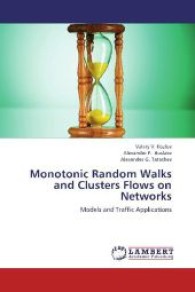- ホーム
- > 洋書
- > 英文書
- > Cinema / Film
Full Description
In the long 1960s, struggles for the rights to abortion, contraception and reproduction itself gathered momentum. This book explores reproduction in American literature and film produced between the late 1950s and the early 1970s, and argues that writers and filmmakers of this period engaged with the social horizons of pregnancy by reflecting on their own creative practices. In an era that witnessed a renewed emphasis on planned pregnancy and population control, authors and filmmakers were often preoccupied with the ways reproduction both cultural and biological might escape the drive to predict and plan. Tracing this preoccupation in key works of drama, film, poetry and prose, Sophie A. Jones argues that these works mobilise the concept of contingency to address the relationships of race, disability and reproductive freedom. Offering fresh perspectives on canonical and lesser-known works, the book makes a case for the central role of culture in forging new approaches to reproductive justice.
Contents
List of Figures
Acknowledgements
Introduction: Reproductive Contingency in the Long 1960s
1. Resisting Reproductive Foreclosure: Hansberry's A Raisin in the Sun (1959)
2. The Birth Film and the Grid: Brakhage's Window Water Baby Moving (1959)
3. Reproducing Revolutionary Road (1961): Repetition and Pronatalism in Yates's Fiction
4. Prosthetic Pregnancies: Reproducing Disability in Plath and Rosemary's Baby (1962-8)
5. Transcending the Maternal Medium: Foetal Images in Nilsson, Sharits and Kubrick (1965-8)
Conclusion: Abortive Space, Abortive Time: Abortion and the Journey in Literature before Roe
Notes
Bibliography
Index






